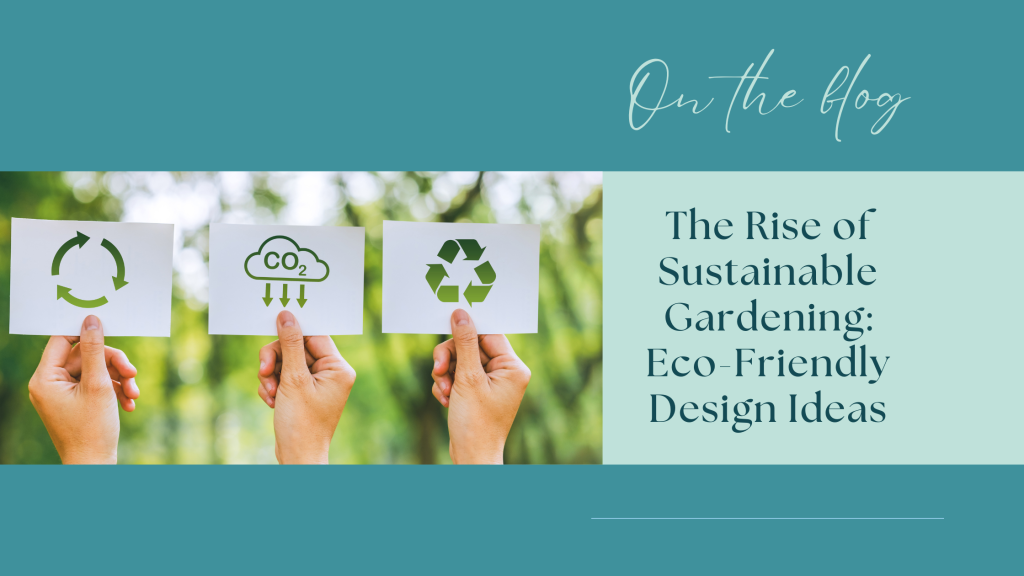As environmental awareness grows, many homeowners and gardeners are shifting towards more sustainable and eco-friendly gardening practices. Sustainable gardening is not only beneficial for the planet, but it also creates beautiful, low-maintenance spaces that support biodiversity and conserve resources. Whether you have a small balcony or a sprawling backyard, there are countless garden ideas that can help you design a space that aligns with your values. In this article, we’ll explore some of the best gardening ideas for eco-friendly design and landscaping.
What Is Sustainable Gardening?
Sustainable gardening refers to the practice of designing and maintaining gardens in a way that minimizes environmental impact while promoting biodiversity, conserving resources, and creating aesthetically pleasing outdoor spaces. It’s a holistic approach that prioritizes eco-friendly methods and materials in every aspect of gardening.
Definition and Key Principles
At its core, sustainable gardening emphasizes working with nature, rather than against it. The key principles of sustainable gardening include:
- Resource conservation: Using water, soil, and energy efficiently to reduce waste.
- Biodiversity promotion: Planting a variety of species that support pollinators, wildlife, and the local ecosystem.
- Soil health: Focusing on composting, mulching, and other techniques to keep soil healthy and productive.
- Low-impact design: Using materials and techniques that have a minimal environmental footprint.
Sustainable gardens aim to be self-sustaining, requiring less effort, fewer chemicals, and reduced resources over time.
Why Sustainable Gardening Matters
As urbanization grows and environmental concerns increase, the need for eco-friendly garden design ideas has never been more urgent. Sustainable gardening practices help reduce water consumption, promote healthy ecosystems, and provide long-term solutions to common environmental challenges like soil degradation and biodiversity loss. Additionally, creating an outdoor garden that uses fewer resources can also reduce your carbon footprint, making your outdoor space both beautiful and eco-conscious.
Eco-Friendly Garden Design Ideas
When designing a sustainable garden, there are plenty of landscaping ideas that can help you make the most of your space while minimizing environmental impact.
Incorporating Native Plants
One of the most effective garden arrangements ideas for sustainable gardening is to include native plants. Native plants are adapted to the local climate, so they require less water, fewer fertilizers, and are more resistant to pests and diseases. By selecting best garden ideas that incorporate native species, you help support local wildlife and ensure a more sustainable, resilient garden.
Water-Wise Gardening
Water conservation is a key element of eco-friendly garden design ideas. Water-wise gardening includes selecting drought-tolerant plants, grouping plants with similar water needs together, and using techniques like mulching to retain moisture in the soil. Installing efficient irrigation systems, such as drip irrigation or soaker hoses, also ensures that water is delivered directly to plant roots, reducing waste.
Companion Planting for Natural Pest Control
Rather than using harmful pesticides, consider implementing companion planting in your garden. This involves planting complementary species together to deter pests and attract beneficial insects. For example, planting marigolds near tomatoes can help repel aphids and other pests. Gardening and landscaping ideas like these not only reduce the need for chemicals but also create a more balanced, resilient garden ecosystem.
Creating a Pollinator-Friendly Garden
Bees, butterflies, and other pollinators play a vital role in our environment, and creating a pollinator-friendly garden can help support these essential creatures. Incorporating a diverse range of flowering plants that bloom at different times of the year is an excellent way to attract pollinators. You can also add garden suggestions planting like bee houses or butterfly habitats to further encourage these beneficial species.
Upcycling and Reusing Materials
Sustainable gardening isn’t just about plants; it also involves using eco-friendly materials. Upcycling and reusing materials for garden structures, such as planters, fences, and pathways, can reduce waste and save money. Look for opportunities to repurpose old wooden pallets, containers, or even scrap metal to create unique and functional garden features.
Sustainable Gardening Practices
While design plays an important role in sustainable gardening, the way you care for your garden also has a significant impact on its sustainability.
Composting and Soil Health
One of the best practices for sustainable gardening is composting. Composting not only helps reduce food and garden waste but also provides rich, nutrient-dense soil for your plants. Healthy soil is the foundation of any successful garden, and using organic methods like composting helps maintain its fertility without relying on synthetic fertilizers.
Reducing Lawn Size
Traditional lawns require large amounts of water, fertilizers, and maintenance, making them an unsustainable option for many gardeners. Reducing lawn size or replacing parts of your lawn with more sustainable alternatives, like native grasses or groundcovers, can save water and reduce your garden’s environmental impact. Consider landscaping ideas that incorporate low-maintenance, drought-tolerant plants instead of traditional grass.
Organic Gardening Methods
Organic gardening methods avoid the use of synthetic chemicals, focusing instead on natural pest control, organic fertilizers, and crop rotation. By adopting organic gardening practices, you create a healthier environment for both plants and wildlife, while also protecting soil and water from harmful chemicals.
Designing for Biodiversity
Biodiversity is a cornerstone of sustainable gardening, and designing your garden with a variety of plant species is essential to supporting local ecosystems.
Building Wildlife Habitats
A garden outside house can become a sanctuary for wildlife. By planting a mix of shrubs, trees, and flowers, you can provide shelter and food for birds, insects, and small mammals. Adding a water feature, such as a birdbath or pond, can also help attract wildlife to your garden. Designing with themed gardens ideas like a wildlife garden or a bird-friendly garden can create a thriving habitat in your own backyard.
Planting for Year-Round Interest
Creating a garden in home design that offers year-round interest is a sustainable choice. Planting a variety of plants that bloom at different times of the year ensures that your garden remains vibrant and beautiful throughout the seasons. Look for plants with varying growth habits, from perennial flowers to evergreen shrubs, to provide continuous color and texture in your garden.
Technology and Tools for Sustainable Gardening
Advancements in technology have made it easier than ever to practice sustainable gardening. From smart irrigation systems to solar-powered garden features, technology can help you conserve resources while enhancing your garden’s beauty and functionality.
Smart Irrigation Systems
One of the most effective ways to conserve water in your garden is by installing a smart irrigation system. These systems use sensors and timers to ensure that your plants receive just the right amount of water. By adjusting watering schedules based on weather conditions, smart irrigation systems help you save water and reduce waste. They’re an excellent addition to outdoor garden ideas focused on sustainability.
Solar-Powered Garden Features
Solar-powered garden features, such as lights, fountains, and even small pumps, are a great way to reduce your garden’s energy consumption. These energy-efficient solutions harness the power of the sun to operate, helping you create a beautiful, eco-friendly garden without relying on electricity from the grid.
Inspiring Sustainable Garden Projects
Finally, there are some exciting and innovative sustainable garden projects that can inspire you to rethink your outdoor space.
Vertical Gardens and Green Walls
Vertical gardens or green walls are a creative way to incorporate sustainable design into smaller spaces. By growing plants vertically, you maximize your garden’s potential without taking up precious floor space. Green walls can also help insulate your home, reduce air pollution, and increase biodiversity.
Urban Gardening Solutions
Urban gardening is an excellent solution for those who live in cities but still want to grow their own food and create sustainable green spaces. From rooftop gardens to community garden projects, there are many ways to incorporate eco-friendly garden design ideas in urban settings. Consider building raised beds or container gardens to grow your favorite vegetables, herbs, and flowers.
Sustainable gardening offers an exciting opportunity to create beautiful, functional, and environmentally responsible outdoor spaces. By implementing creative garden ideas, choosing native plants, conserving water, and embracing organic practices, you can design a garden that not only enhances your home but also supports the planet. Whether you’re looking for unique landscaping ideas or practical gardens design ideas, there’s no better time to start building your eco-friendly garden.



